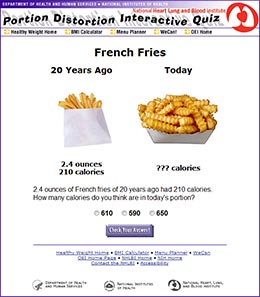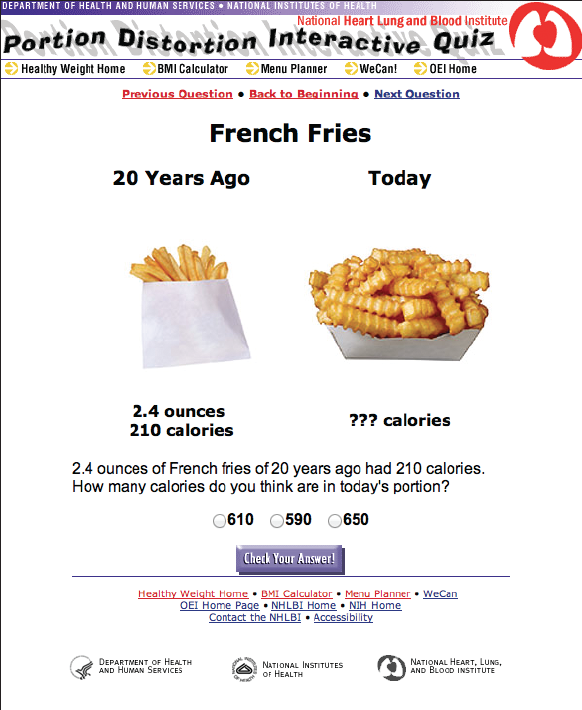By Candace Chemtob, B.S. and M.S. in Human Nutrition
Just look around and you can see that America’s waistline is expanding. More than 2/3 of Americans are overweight or obese, with an astonishing 75 million (35.7%) Americans classified as obese (BMI>30). The rate at which Americans are becoming obese is also alarming, and if this trend continues half of Americans will be obese by 2030 (CDC.gov). While the cause of the “obesity epidemic” is multifactorial, one of the contributing factors is increasing portion sizes.
Over the past two decades, portion sizes have increased dramatically. For example, the average bagel has more than doubled in size and calories, from 140 to 340 calories, (nih.gov). Bagels are not the exception, “super-sized” portions are everywhere. Restaurants are often the worst offenders. The Cheesecake Factory, one of America’s favorite restaurants, can serve up a hefty amount of calories even in a seemingly “healthy” meal. For example, if you were to order an artichoke appetizer, soda, Farfalle with Chicken and Roasted Garlic, side of fries, and carrot cake, your meal would contain almost 5,000 calories (www.thecheesecakefactory.com)! This level of intake is sufficient to meet the energy (calorie) needs of most adults for two entire days. While this information should be shocking, it makes the “obesity epidemic” easier to understand.
 “Super-sizing” has caught the attention of not only health professionals, but also politicians. Most recently, Mayor Bloomberg of NYC made a bold move to limit the serving size of sugar (or should I say high fructose corn syrup) laden soft drinks. This move sparked plenty of controversy but raised awareness about the dangers of consuming large portions of unhealthy, calorie-rich foods. And why not raise awareness of the health dangers of overeating and obesity? Obesity causes heart disease, hypertension, diabetes, sleep apnea, and cancer, and is the number two preventable cause of death in America.
“Super-sizing” has caught the attention of not only health professionals, but also politicians. Most recently, Mayor Bloomberg of NYC made a bold move to limit the serving size of sugar (or should I say high fructose corn syrup) laden soft drinks. This move sparked plenty of controversy but raised awareness about the dangers of consuming large portions of unhealthy, calorie-rich foods. And why not raise awareness of the health dangers of overeating and obesity? Obesity causes heart disease, hypertension, diabetes, sleep apnea, and cancer, and is the number two preventable cause of death in America.
Why is this important to squash players, who for the most part are a healthy subsection of Americans? Let’s go back to the Cheesecake Factory example. To burn off an extra 5,000 calories, you would need to run TWO marathons (almost, using the rule of thumb 100 calories burned per mile), or play over six hours of continuous, high level competition squash without breaks. In other words, it’s just not feasible to burn off these excessive calories!! Even a vigorous squash match will not come even close to burning off a “super-sized” meal.
Making the assumption that squash players dine out with the same frequency as the rest of Americans, this would be five meals per week on average. The vast majority of these meals are consumed at fast food or casual dining restaurants (Harris Poll, 2012), which cater to customers seeking a “good value”. Good value means larger portions with a low price tag. The Cheesecake Factory is not the only popular restaurant serving up these “super-sized” meals. Applebee’s Provolone Stuffed Meatballs with Fettucine and garlic bread contains a whopping 1520 calories, which makes a Whopper (Burger King), look like a “kids menu” item at 670 calories.
Humans are wired to eat more, when food is plentiful. After all for most of human history, food has been a scarce resource and survival was dependent on eating when food was available. Multiple studies have shown that larger portions lead to increased caloric intake. A study by Roll, et al. found that doubling portion size resulted in participants eating 30% more calories as compared to the smaller portion. Interestingly, 45% of the participants did not even notice the change in portion size, nor did it influence their hunger or fullness.
The combination of the increased portion sizes and our innate drive to eat more, can lead to overeating and you might not even realize it. These excessive calories can add up quickly, and expand the waistline of even the most active squash player. Gaining weight is not difficult. Consuming an extra 500 calories per day for seven days will make you one pound heavier. Therefore, it is best to avoid the “portion distortion” trap and follow some simple strategies for eating out and at home:
- Until nutrition labeling is mandatory at all restaurants, do some research. If you frequent a restaurant regularly, look up their nutritional information and use it to make healthy food choices.
- Choose simply prepared foods. Order foods that are grilled, baked, or steamed. Avoid foods with sauces and fried foods. Terms such as basted, batter-dipped, breaded, creamy, crispy, scalloped, au gratin or butter sauce describe high fat, calorie foods.
- Never “supersize”, avoid buffets. Pass on the bread or chip basket.
- When dining out, an appetizer may be enough for a meal.
- Don’t order both an appetizer and an entree.
- Share a meal or take half home.
- Don’t go to a restaurant starving, you will not make the healthiest choices in an unfed state.
- At home, consider using a smaller plate, turning the TV off when dining, take out one portion only and put the rest away.
- Get familiar with serving sizes suggested by the American Dietetics Association and the NIH sizes (hp2010.nhlbihin.net/portion/keep.htm). For example, a 3-oz portion of meat is the size of an iPhone 5 and for chicken it is the size of a computer mouse.


